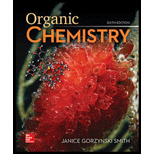
Concept explainers
(a)
Interpretation: The condensed formula of the given molecule is to be converted to skeletal structure.
Concept introduction: Skeletal structures can be drawn for organic compounds which contains both rings and chains of atoms. Carbon chains are drawn in a zigzag fashion and rings are drawn as polygons.
(b)
Interpretation: The condensed formula of the given molecule is to be converted to skeletal structure.
Concept introduction: Skeletal structures can be drawn for organic compounds which contains both rings and chains of atoms. Carbon chains are drawn in a zigzag fashion, and rings are drawn as polygons.
(c)
Interpretation: Condensed formula of the given molecule is to be converted to skeletal structure.
Concept introduction: Skeletal structures can be drawn for organic compounds which contains both rings and chains of atoms. Carbon chains are drawn in a zigzag fashion, and rings are drawn as polygons.
(d)
Interpretation: Condensed formula of the given molecule is to be converted to skeletal structure.
Concept introduction: Skeletal structures can be drawn for organic compounds which contains both rings and chains of atoms. Carbon chains are drawn in a zigzag fashion, and rings are drawn as polygons.
(e)
Interpretation: Condensed formula of the given molecule is to be converted to skeletal structure.
Concept introduction: Skeletal structures can be drawn for organic compounds which contains both rings and chains of atoms. Carbon chains are drawn in a zigzag fashion, and rings are drawn as polygons.
(f)
Interpretation: Condensed formula of the given molecule is to be converted to skeletal structure.
Concept introduction: Skeletal structures can be drawn for organic compounds which contains both rings and chains of atoms. Carbon chains are drawn in a zigzag fashion, and rings are drawn as polygons.
Want to see the full answer?
Check out a sample textbook solution
Chapter 1 Solutions
ORGANIC CHEMISTRY (LOOSELEAF)
- consider the rate of the reaction below to be r. Whats the rate after each reaction? Br + NaCN CN + NaBr a. Double the concentration of alkyl bromide b. Halve the concentration of the electrophile & triple concentration of cyanide c. Halve the concentration of alkyl chloridearrow_forwardPredict the organic reactant that is involved in the reaction below, and draw the skeletal ("line") structures of the missing organic reactant. Please include all steps & drawings & explanations.arrow_forwardWhat are the missing reagents for the spots labeled 1 and 3? Please give a detailed explanation and include the drawings and show how the synthesis proceeds with the reagents.arrow_forward
- What is the organic molecule X of the following acetal hydrolysis? Please draw a skeletal line structure and include a detailed explanation and drawing of how the mechanism proceeds. Please include any relevant information that is needed to understand the process of acetal hydrolysis.arrow_forwardWhat are is the organic molecule X and product Y of the following acetal hydrolysis? Please draw a skeletal line structure and include a detailed explanation and drawing of how the mechanism proceeds. Please include any relevant information that is needed to understand the process of acetal hydrolysis.arrow_forwardAt 300 K, in the decomposition reaction of a reactant R into products, several measurements of the concentration of R over time have been made (see table). Without using graphs, calculate the order of the reaction. t/s [R]/(mol L-1) 0 0,5 171 0,16 720 0,05 1400 0,027arrow_forward
- Predict the organic products that form in the reaction below, and draw the skeletal ("line") structures of the missing organic products. Please include all steps & drawings & explanations.arrow_forwardWhat are the missing reagents for the spots labeled 1 and 3? Please give a detailed explanation and include the drawings and show how the synthesis proceeds with the reagents.arrow_forwardWhat are the products of the following acetal hydrolysis? Please draw a skeletal line structure and include a detailed explanation and drawing of how the mechanism proceeds. Please include any relevant information that is needed to understand the process of acetal hydrolysis.arrow_forward
- What would happen if you added the HCI to the Grignard reagent before adding benzophenone? Draw a reaction mechanism to support your answer.arrow_forwardAt 300 K, in the decomposition reaction of a reactant R into products, several measurements of the concentration of R over time have been made (see table). Calculate the order of the reaction. t/s [R]/ (mol L-1) 0 0,5 171 0,16 720 0,05 1400 0,027arrow_forwardWrite the correct IUPAC names of the molecules in the picturearrow_forward
 Living By Chemistry: First Edition TextbookChemistryISBN:9781559539418Author:Angelica StacyPublisher:MAC HIGHER
Living By Chemistry: First Edition TextbookChemistryISBN:9781559539418Author:Angelica StacyPublisher:MAC HIGHER
